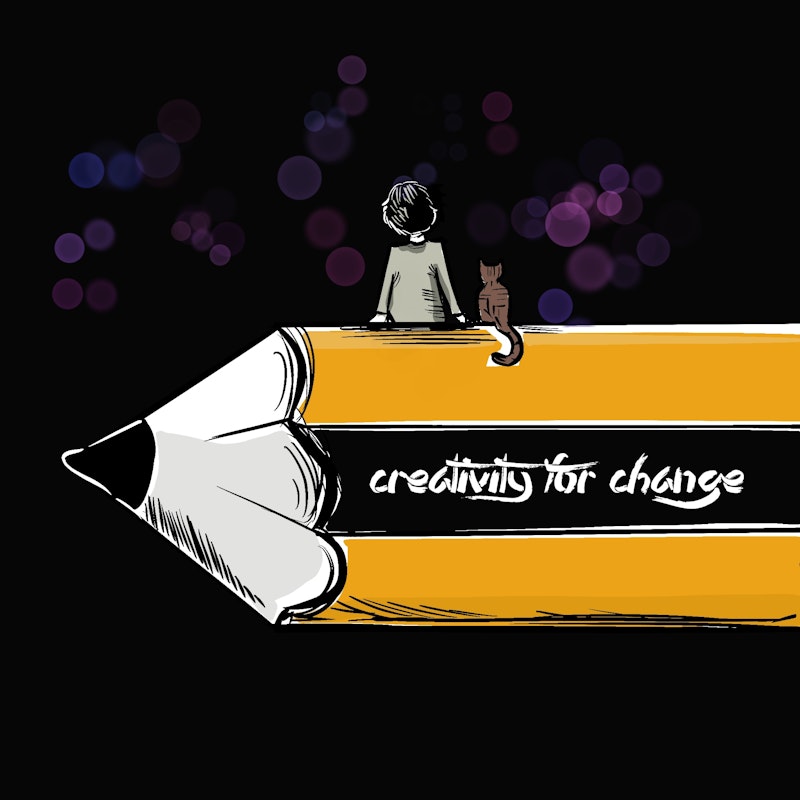Last year, one of my biggest collaborations was with HUMAN RIGHTS PULSE. I wrote an article entitled "Cartooning for Change" for their ArtPulse section. I am reproducing the article below which can also be read directly on their website here.
THE BEGINNING
I have always loved drawing. As a child, my favourite pastime was doodling and reading cartoon magazines such as MAD, Ujang and Gila-Gila (they are famous Malaysian magazines). Growing up, I did not have the confidence to take up art more seriously or to share my work with anyone. 10 years ago, I finally realised my passion and believed in my talent as a cartoonist and comic artist.

Figure 1 My cartoon on the Arab Spring drawn in 2011
It was the year of the Arab spring. I was in the United Kingdom, pursuing my post-graduate study at the University of York. It was the same year that I also came to terms with my mental health problem. To channel my frustrations and beat my loneliness, I started to draw cartoon sketches of my experience dealing with my mental health issue. Gradually, some of my classmates started to notice my talent. I recalled my first Arab-spring inspired cartoon. It was raw and amateur, drawn with an ink pen on an A4 paper that was later scanned and edited with my haggard iPhone. My cartoon strokes were hasty and careless- marking the work of a very eager but inexperienced artist. Despite the limitations, I found the ability to express my views through my cartoons very liberating. From cartoons on Arab Spring shared in the Middle East students’ Facebook page, my catalogue of work grew. Living in the UK exposed me further to the art and comic scene. I started to immerse myself in the work of Joe Sacco , and Art Spiegelman . These new discoveries continued to strengthen my conviction in the power of visual storytelling. In 2013, I moved to Switzerland for a new job and thus began my journey to find my voice as a comic artist and cartoonist.
WHY DO I DRAW CARTOONS AND COMICS?
Drawing my views about human rights came naturally to me. As Marjane Satrapi , a comic artist, succinctly put it: “Drawing is the first language of the human being before writing. It is a transcription of how the human being sees reality, not reality itself”. Drawing cartoons or comics is my way of digesting and making sense of my reality and worldview, particularly during the COVD-19 pandemic. We all were seeking ways and outlets to process the situation and for me, it was by translating my views and feelings into cartoons or comics.
Human rights issues are often complex, but they are presented in the media or official documents in ways that are either unrelatable or sensationalised for the public. Such an approach risks dehumanising the victims in those cases. On the contrary, I find comics and cartoons as persuasive and palatable forms of communication that could build public understanding and empathy about human rights. Furthermore, the power of image transcends language, social barriers and textual or verbal complexities. Remember the Sunday comic strips - Snoopy or Garfield?
During the pandemic, I drew cartoons depicting some of the glaring human rights problems faced by communities around the world. While I drew inspiration from different contexts, themes such as hope, fear, grief, and loneliness are universal. A cartoon I drew on the sense of isolation suffered by an old man, was based on the tragic deaths in a South Korean long term care facility when the pandemic began. In the news report, the fear of “living alone”, “losing contact with the outside world” or “dying of loneliness” were recurring themes.
The elderly, persons with mental health issues, forced migrants, and children in conflict zones are some examples of vulnerable people that continue to be invisible and forgotten, especially during the pandemic. My cartoons aim to bring to light the plight of the voiceless and the universal themes associated with their issues. Artists, in general, may choose and have chosen to refrain from injecting empathy in their work. As a human rights advocate, I struggle to remain neutral or apathetic with my comics and cartoons. I concur with what Joao de Brito, a Portuguese-American impressionist, once said: “empathy is what is channelled by many artists to express what needs to be seen or heard from the public when the world is in confusion”.
CARTOONING AND HUMAN RIGHTS ADVOCACY
Cartoons and comics are a powerful medium to expose injustices and idiosyncrasies that are often overlooked or avoided by mainstream media. My work as a human rights advocate enabled me to collaborate with other human rights defenders, torture survivors, and governments on a regular basis. When I shared my cartoons in talks or workshops, the discussions that followed were enriched with perspectives that were beyond the issues or problems depicted in the cartoons. People were engaged and excited to use the cartoons as an entry point to explore bigger subjects such as impunity, sexism, or discrimination.
As I draw more cartoons and comics, the lessons I learned along the way help me establish some key steps in my creative process. They include the importance of building the right messages for the right audience, respecting the stories, data, and contexts, especially when it involves persons living in vulnerable situations, and injecting elements of hope and empathy in the artwork. Furthermore, it is also important that my artworks celebrate human resilience, the power of the people, and their potential to drive change. I want to ensure that the cartoons and comics I draw not only highlight the problems, but offer positive visual narratives that can cultivate hope and inspire dialogue about human rights.
I will continue to mobilise human rights advocacy and discourse in my work, one cartoon at a time.
